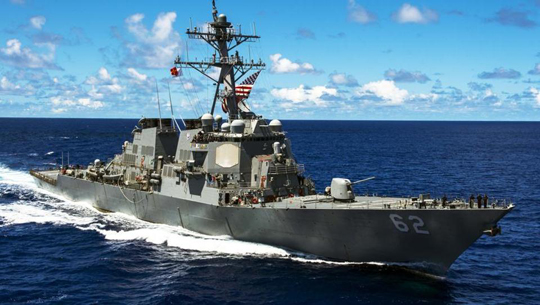Tokyo, Jun 17: Seven Navy sailors were missing and at least two, including the captain, were injured after a US destroyer collided with a merchant ship off the coast of Japan before dawn Saturday, the US Navy and Japanese coast guard reported.

Footage from the Japanese TV network NHK showed heavy damage to the mid-right side of the USS Fitzgerald and a person in a stretcher being lifted to a helicopter.
The first, Cmdr. Bryce Benson, was taken to the US Naval Hospital in Yokosuka and was in stable condition, the US 7th Fleet said in a statement. It said another injured person was being evacuated but gave no further details on the crew’s injuries. Others hurt in the crash were being evaluated, it said.
The Fitzgerald had limited propulsion after suffering damage on the starboard side below the water line and a US defense official said there was flooding in three compartments. It wasn’t clear yet what caused the nighttime collision between the destroyer and the container ship four times its size. Most of the more than 200 sailors would have been asleep in their berthings, some of which were reportedly flooded.
The Navy, Japanese maritime defense vessels and the coast guard were working to stabilize the destroyer as it headed to shore, said Navy chief Adm. John Richardson.
The Navy said that the collision occurred 56 nautical miles (103 kilometers) southwest of Yokosuka, which is home to the 7th Fleet. Footage showed the damaged ship moving slowly in calm seas, flanked by a tugboat.
“Right now we are focused on two things: the safety of the ship and the well-being of the sailors,” said Adm. Scott Swift, commander of the US Pacific Fleet.
The Japan coast guard said it received an emergency call from a Philippine-registered container ship ACX Crystal around 2:20 a.m. (1720 GMT Friday) that it had collided with the Fitzgerald southwest of Yokusuka, Japan.
Relatives of crew members were awaiting news of their loved ones.
“Of course we’re nervous and scared and just praying,” Rita Schrimsher said by telephone from Athens, Alabama.
Her grandson Jackson Schrimsher is a 23-year-old sailor aboard the Fitzgerald. She said she last communicated with him via Facebook messenger on Wednesday.
Takeshi Aikawa of the Japan coast guard said that so far no damage or injuries were reported on the container ship, he said. NHK reported that the merchant ship had scratches on the left side of its bow.
The Philippine ship is 29,060 tons and is 222 meters (730 feet) long, the coast guard said.
The fleet said the USS Dewey, medical assistance, Navy tugs and naval aircraft were dispatched. The Japan coast guard dispatched five patrol ships and an aircraft carrying medics to the site for search and rescue operations.
The Navy’s Pacific Fleet said the extent of damage to the Fitzgerald was being determined and the incident was under investigation.





Comments
Add new comment